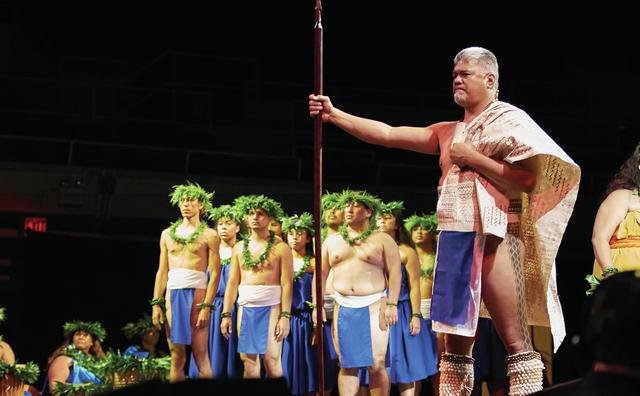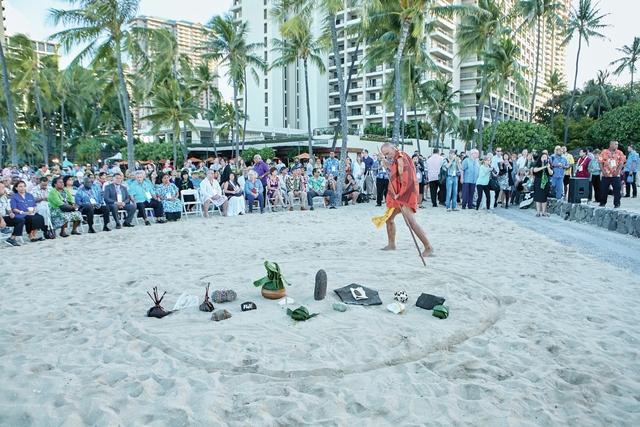HONOLULU — Planet at the crossroads was the theme for the International Union for the Conservation of Nature (IUCN) conference that began in Honolulu Sept. 1 and concluded on Monday. Held every four years, it was the first time the conference had been held in the United States.
Makali’i Ohana Waa, based in Waimea, and the Dryland Forest Hui Ohana were two of many representative groups from the Big Island that attended the conference, where the connection of culture and nature was highlighted.
The opening ceremony, with dignitaries from around the world, took place on the shore.
“We started off Wednesday morning with the opening ceremonies on Kahanamoku Beach in front of the Hawaiian Hilton Village. We wanted to ground them and give them a feel for the culture in the Pacific regions and what our traditions are,” said Maulili Dickson, Na Kalai Waa canoe captain and quartermaster. “We welcomed them with traditional haka chants and we had some of our lua experts challenge them coming ashore.”
The ceremony for the Pacific Island nations continued at Blaisdell Center in downtown Honolulu.
“Aunty Pualani Kanahele from Kanakaole Foundation, her halau and the people of Hilo are the ones that did the traditional, cultural part of that,” Dickson said.
And like a fish net being flung wide, “They started in the middle of the floor and walked out from there. Their leader was Kamanaopono Crabbe in malo (loincloth) and kapa kihei (shawl),” he added.
For the next day and a half Pacific Island nation groups, including the ever-growing Ohana Waa, shared their knowledge and experiences.
“We had Aoteraroa, Tahiti, Cook Islands, Palau, Marshall Islands and more. We were there in conjunction with the World Wide Voyage,” Dickson said.
The mission of the World Wide Voyage is to raise awareness of the environmental challenges being faced by the entire planet, especially Pacific islanders.
“All the Ohana Waa are in unison. The Pacific nations have to start looking at how we can better our environments, starting at home,” Dickson said.
President Obama was certainly starting at home with his Sept. 1 announcement of the expansion of the Papahanaumokuakea Marine National Monument to create the largest marine preserve on Earth. This is good news for the Ohana Waa, according to Dickson, who sees the potential for more and shorter canoe training runs.
The IUCN conference was also an opportunity for policymakers and administrators to see the results of many such efforts, and possibly influence decision making and funding. Palau President Tommy Remengesau Jr. wowed the assembly with his country’s impressive environmental accomplishments, focusing on grassroots action.
“Palau is one of the leading Pacific nations that are actually doing something. With reefs, recycling and energy use they’re doing it, rather than talking and policy-making, like our Makali’i community. You work with what you got. The more people you get involved from the community, the more resources become available,” Dickson said.
The Dryland Forest Hui Ohana highlights a ground up approach to conservation work. The Hui is an informal group comprised of Kaloko-Honokohau National Park; Kaupulehu Dryland Forest Preserve; Kiholo Bay Restoration Project; Mauna Kea Forest Restoration Project; Puuwaawaa Forest Reserve; and Waikoloa Dryforest Initiative.
The group came together with the realization that much more can be accomplished by pooling resources. They gather once a month to work on individual projects and to share knowledge and resources.
The Hui’s presentation at the conference was well received and attended by a wide range of people who wanted to know just how they do what they do.
“One of the things that stood out to me was when Evan Paxton from the USGS mentioned that this is a really rare model of collaboration in his eyes. He asked us about how we collaborate and hurdles we have overcome,” said Elliott Parsons, Puuwaawaa’s volunteer coordinator.
But to the Hui, sharing resources and working together is foundational, a natural outcome of life in the islands.
One attendee from Bonaire, a small island in the Caribbean, is working on reforesting Klein Bonaire, an even smaller island where the forest has all but disappeared. This was familiar ground for the Hui, as 95 percent of the dryland forest in Hawaii is gone.
“With the Hui, we can create five acres of dryland forest in one day,” Parsons said. “Maybe in a year or so we can talk about what percentage of the dryland forest is available because of their work.
The conference was an inspiration and an awareness-raising experience as well.
“We think we have it really bad in Hawaii and we have challenges, but there are many places around the world that are facing even more dire conservation struggles,” Parsons said. “It was really good to get out of our bubble.”
The relationship of culture and nature was a main theme throughout the conference, and the focus of a session called “Standing on Sacred Ground” about the struggles of eight indigenous communities to preserve their sacred sites.
“A filmmaker brought representatives from these communities to come and share their stories. One of them was from Papua New Guinea and he stood up and said, ‘I’ve never left the bush before.’ It was heart wrenching to hear of their struggles. We’re not the only ones struggling with trying to conserve nature, and there are various ways we can help each other,” Parsons said.
The IUCN was like the weaving of a fish net — the lines of many people connecting and being woven together, to create a net that when flung wide, will feed and sustain the planet and its people.









